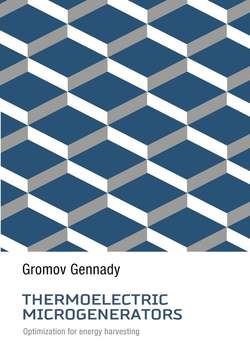Thermoelectric Microgenerators. Optimization for energy harvesting

Реклама. ООО «ЛитРес», ИНН: 7719571260.
Оглавление
Gennady Gromov. Thermoelectric Microgenerators. Optimization for energy harvesting
Preface
Chapter 1. Introduction
Chapter 2. Physical basics
Heat balance equations
Main parameters
Effective thermal conductivity and thermal resistance
Chapter 3. Optimization of electrical circuit
Basic formulas
Maximum power
Chapter 4. Optimization of efficiency
General formula
Maximum efficiency and maximum power modes
Efficiency and Carnot cycle
Chapter 5. Optimization of thermal resistance
Thermal resistance
Net power
Maximum power
Physical sense
Particular solutions
Thermal resistance of working generator
Chapter 6. Design optimization
Introduction
Number of thermoelements
Form-factor of thermoelements
Thermal resistance
Coefficient of performance
Heat flow density
Chapter 7. Thermoelectric materials
Typical parameters
Voltage
Maximum power
Coefficient of performance
Efficiency and Figure-of-Merit
Conclusions
Chapter 8. Interconnection of generators
Connection schemas
Key ratios
Parallel and serial connection
Stack parallel and serial connection
Notes
Chapter 9. Analysis of the environment
Thermal resistance
Example
Chapter 10. DC-DC Converters
Introduction
Modern converters
Efficiency of converters
Chapter 11. Bulk or Thin-film
Introduction
Compare electrical characteristics
Coefficient of performance
Conclusions
Chapter 12. Universal series of microgenerators
Introduction
Module design
Geometry of thermoelements
Number of thermoelements
Packing density
Plates
Classification and labelling
Universal series
Standard specification
Chapter 13. Practice nomenclature
Description
Power and dimensions
Power density
Thermal resistance and power
Chapter 14. Thermoelectric coolers as generators
Introduction
Relationship of parameters of cooling and generator modules
General conclusion
Chapter 15. Ideal and real
Introduction
Ideal approach
Real approach
Conclusions
Chapter 16. Universal algorithm
Task statement
Algorithm for calculating
Sample implementation
Algorithm schematics
Chapter 17. Practical tasks
Introduction
Low-power heat sources
Sources of medium temperature difference range
Sources of high temperature difference range
General conclusion
Chapter 18. Examples of energy harvesting
Introduction
The classical task
Built-in generator
Heat source of low heat flow density
Nonstationary heat source
Chapter 19. Equipment for control and researches
Introduction
Measurement of parameters of micromodules
Research equipment
Chapter 20. Markets and applications
Market prospects of energy harvesting
Automotive, transport
Wireless electronic devices and sensors
Miniature radioisotope thermoelectric generators
Utilization of human body heat
Household
Industrial applications, sensors
Other application
Chapter 21. Useful formulas
Heat balance equations
Thermoelectric Figure-of-Merit
ThermoEMF
Electric current
Maximum current
Working voltage
Electrical resistance of the generator
Ratio of load resistance and internal resistance
Net power conversion
Heat flow density
Thermal conductivity of working generator
Thermal resistance
Efficiency
Radiation heat transfer
Heat convection
Generator efficiency and cooling capacity
Current and voltage of generator and cooling capacity
Thermal resistance of generator and cooling mode
Formulas for connections of two generators
List of symbols
Bibliography
Further reading
Annex. Microgenerators universal series
Introduction
Series 1XC06
Series 1XC04
Series 1XD06
Series 1XD04
Series 1XD03
Series 1XDD02
Отрывок из книги
The idea for this book came from the experience. Our team is in thermoelectric business for over 20 years. Firstly, for many years it was thermoelectric cooling solutions for miniature applications. In recent years, thermoelectrics moves in microgenerators trend. Green energy, energy harvesting…
Promising directions – applications of thermoelectric microgenerators for tasks of low energy – recycling waste heat surrounding thermal sources, of human body energy harvesting and so on.
.....
Figure 2.3 Dependence of dimensionless factor F from ratio m=Rload/ACR.
Maximum F and, respectively (2.16), maximum power P are achieved when m=1, i.e.
.....